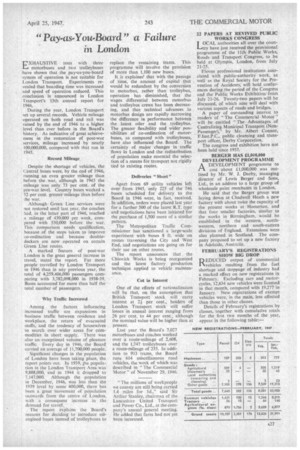" Pay , as-You-Board " a Failure in London E XHAUSTIVE tests with
Page 29

If you've noticed an error in this article please click here to report it so we can fix it.
three motorbuses and two trolleybuses have shown that the pay-es-you-board system of operation is not suitable for London Transport. Experiments revealed that boarding time was increased
, and speed of operation reduced. This conclusion is announced in London Transport's 13th annual report for 1946.
During the year, London Transport set up several records. Vehicle mileage operated on both road and rail was raised by the end of 1946 to a higher level than ever before in the Board's history. As indicative of great achievement in the restoration of post-war services, mileage increased by nearly 100,000,000, compared with that run in 1945.
Record Mileage Despite the shortage of vehicles, the Central buses were, by the end of 1946, running an even greater mileage than before the war, although in 1945 the mileage was only 73 per cent. of the pre-war level. Country buses worked a 52 per cent, greater mileage than before the war.
Although Green Line services were not restored until last year, the coaches had, in the latter part of 1946, reached a mileage of 430,000 per week, compared with 530,000 before the war. This comparison needs qualification, because of the steps taken to improve co-ordination and because doubledeckers are now operated on certain Green Line routes.
A marked feature of post-war London is the great general increase in travel, states the report. Far more people travelled by London Transport in 1946 than in any previous year, the total of 4,259,406,000 passengers comparing with 3,782,098,000 in 1938-39. Buses accounted for more than half the total number of passengers.
Why Traffic Increased Among the factors influencing increased traffic are expansions in business traffic between residence and workplace, the return of evacuated staffs, and the tendency of housewives to search over wider areas for commodities in short supply. There was also an exceptional volume of pleasure traffic. Every day in 1946, the Board carried an average of 11,700,000 people.
Significant changes in the population of London have been taking place, the report points out. In 1939, he popula-, tion in the London Transport Area was 9,888,000, and in 1944 it dropped to 7,147,000. Although the population in December, 1946, was less than the 1939 level by some 400,000, there has been a great movement of population outwards from the centre of London, with a consequent increase in the demand for travel.
The report explains the Board's reasons for deciding to introduce oilengined buses instead of trolleybuses to replace the remaining trams. This programme will involve the provision of more than 1,100 new buses.
It is exp1ainec1 that with the passage of time, the amount of capital that would be redundant by the conversion to motorbus, rather than trolleybus, operation has diminished, that the wages differential between motorbus and trolleybus crews has been decreasing, and that technical advances in motorbus design are rapidly narrowing the difference in performance between the latest oiler and the trolleybus. The greater flexibility and wider possibilities of co-ordination of motorbuses, as compared with trolleybuses, have also influenced the Board. The certainty of major changes in• traffic flows in London and the redistribution of population make essential the selection of a means for transport not rigidly tied to existing routes.
Deliveries " Short " Apart from 69 utility vehicles left over from 1945, only 225 of the 746 buses scheduled for delivery to the Board in 1946 were, in fact, received. In addition, orders were placed last year for a further 500 of the latest R.T. type and negotiations have been initiated for the purchase of 1,500 more of a similar pattern.
The Metropolitan Traffic Commissioner has sanctioned a large-scale experiment with buses 8 ft. wide on routes traversing the City and West End, and negotiations are going on for their use on other routes.
The report announces that the Chiswick Works is being reorganized and the latest factory production technique applied to vehicle maintenance.
Cut in Interest One of the effects of nationalization will be that, on the assumption that British Transport stock will carry interest at 21 per cent., holders of London Transport stock will stiffer losses in annual interest ranging from 26 per cent, to 44 per cent., although the nominal value will be higher than at present.
Last year the Board's 7,027 motorbuses and coaches worked over a route-mileage of 2,608, and the 1,747 trolleybuses over a route-mileage of 255. In addition to 913 trams, the Board runs 614 miscellaneous road vehicles, the work of which was described in "The Commercial Motor" of November 29, 1946.
The millions of workpeople we convey are still being carried 1.4 miles for Id.," said Sir Arthur Stanley, chairman of the Lancashire United Transport and Power Co., Ltd., at the company's annual general meeting. He added that fares had not yet been increased.












































































